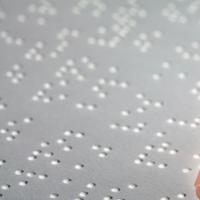World Braille Day
Today, January 4th, is World Braille Day marking Louis Braille’s birthday. Although the Braille tactile writing system was invented about 200 years ago, there have been many technological challenges in adapting it to the computerized age.

A recent breakthrough published in the Proceedings of the National Academy of Sciences (PNAS) heralds a new generation of compact and efficient Braille monitors. The findings by researchers at the Technion and Cornell University present a “robotic Braille monitor” with a dynamic silicone surface and small Braille “bubbles” on top of it. The development is based on the flow of methane and oxygen into the silicon surface and the swelling of these “bubbles” using controlled micro-scale combustion and without any need for a pump.

The study’s authors, Prof. Amir Gat and Ph.D. student Ofek Peretz from the Technion Faculty of Mechanical Engineering, are engaged in broader research of soft robotics. This area draws great inspiration from biological tissue and natural organs such as an elephant’s trunk and an octopus’ arm, creating articulated robots, using flexible tubes actuated by internal fluids. The flow of the liquid into different patterns affects the flexible device in different ways, and a well-designed system can lead to precise movement and efficient control.

Louis Braille, born January 4,1809, lost his sight at the age of five. His father created a wooden board for him with nails in the shape of alphabet letters. At the age of 15, Braille developed the code now known as Braille.
For the article in PNAS click here
Videos:


